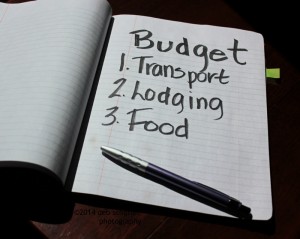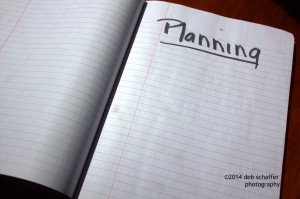Budgeting is a dirty word to many people. That word conjures up deprivation, counting pennies, and overall unhappiness. Folks often feel that if you need a budget to travel, you don’t have enough money to have a good time. Fortunately, that is not true.
Determining the budget is an important part of trip planning. There are a few steps to determining your budget. Pull out a piece of paper and a pencil and work through the next few steps.
1. Think about how much money you can spend on this journey. This is different for everyone since each household has different monthly expenses. A quick glance around the Web leads me to believe there is no one perfect rule of thumb for a vacation budget. My thought is that the budget should start at about one week’s salary. If you can’t spend one week’s salary and still make all your bills for that month, re-evaluate your plans. Make a note of your first budget number.
Avoid using credit cards to increase your budget unless you can pay them in full when you return. This is not a personal finance blog so I won’t go into why using credit cards that you can’t pay when the bill arrives is a bad idea. Trust me on this.
2. Consider that for many decent vacations, budgeting around $100 per person per day for food and lodging – not counting transportation costs – is a good starting point. This amount won’t set you and your family up at the Ritz or the Four Seasons, but you should be able to find a decent hotel and eat well on that amount in most vacation destinations around the world.
If your heart is set on New York City, Paris, London, or San Francisco at Christmas then $100 per day may not be enough. Be reasonable. Write down the number of travelers times the number of days you expect to be gone and put two zeros on the end. For example: 2 travelers x 5 days = $1000.
Note for those with small children. Many hotels don’t charge for small kids when they stay in the same room as the parents. They also don’t tend to eat much. Adjust daily costs accordingly – say to $20 for each kid under 6.
3. Add transportation to the $100 per person per day budget. The biggest part of most vacation budgets are transportation and lodging. Airfare can be difficult to budget, but most destinations stay in a specific range most of the year. For example, from Denver to Detroit, airfare usually runs between $250 and $300 per person, round-trip. I happen to know that in January, the fares can run half that. I’ve gotten fares between Denver and Hawaii as low at $495 per person, round-trip, direct. However, I also know that city pair is usually in the $700 range most of the year. Do a little digging. Set a fare alert on FareCompare or Adioso and track the prices. The typical round-trip fare becomes apparent. Do a bit of math and come up with a round number on how much transport is going to cost. Write it down.
Sometimes, particularly with families, it is really too expensive to fly. U.S.-based airlines are not sympathetic to families sitting together or boarding early, charging fees for each passenger that asks for special treatment. Consider a road-trip if the distances allow. This could be a different, though cheaper, version of insanity but you’ll still get there. Think about fuel costs, wear and tear on your car, and any hotel stays when calculating these costs.
In some areas of the U.S. trains are an option. Unfortunately, they are not a good option for most locations from Denver, but those on the East Coast have more opportunities. Calculate the fare, including any overnight berths that are available or necessary.
Write down the estimate of your transportation costs. You should now have three numbers on your paper:
-
Your initial guess
-
Lodging/food number
-
Transportation estimate
Add the second number to the third and compare it with your initial guess. Hopefully the sum of two and three is less than or equal to your initial guess. If not, then something has to change. Reconsider your initial guess, review your transportation costs, then reconsider the lodging and food amounts. The goal is to come up with a reasonable amount for the basics of the vacation. Only then can the rest of the trip be added in – excursions, side trips, theme parks, lift tickets.
We’re about half way through determining a budget for your journey. There’s more, but spend a day or two thinking about these items before going on to the next steps.
Remember, you’re planning to enjoy yourself. This process helps. In the next post, we’ll talk about finalizing the budget and ways to do more with less money.
Like this article? Subscribe by adding your email or by clicking the RSS link at the top of the page to get the latest information by email when it’s published. For more fun deals and information, follow Deb on Twitter at debtalkstravel.

